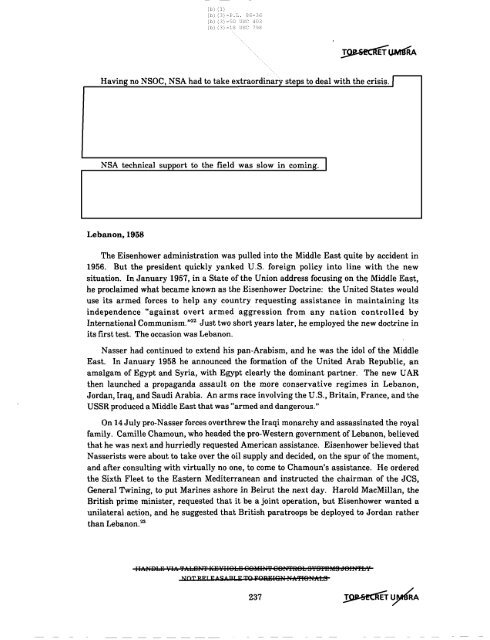American Cryptology during the Cold War - The Black Vault
American Cryptology during the Cold War - The Black Vault
American Cryptology during the Cold War - The Black Vault
You also want an ePaper? Increase the reach of your titles
YUMPU automatically turns print PDFs into web optimized ePapers that Google loves.
Ib) (1)<br />
Ib) (3) -P.L. 86-36<br />
Ib) (3) -50 USC 403<br />
Ib) (3) -18 USC 798<br />
Having no NSOC, NSA had to take extraordinary steps to deal with <strong>the</strong> crisis. I<br />
NSA technical support to <strong>the</strong> field was slow in coming. I<br />
Lebanon, 1958<br />
<strong>The</strong> Eisenhower administration was pulled into <strong>the</strong> Middle East quite by accident in<br />
1956. But <strong>the</strong> president quickly yanked U.S. foreign policy into line with <strong>the</strong> new<br />
situation. In January 1957, in a State of<strong>the</strong> Union address focusing on <strong>the</strong> Middle East,<br />
he proclaimed what became known as <strong>the</strong> Eisenhower Doctrine: <strong>the</strong> United States would<br />
use its armed forces to help any country requesting assistance in maintaining its<br />
independence "against overt armed aggression from any nation controlled by<br />
International Communism.,,22 Just two short years later, he employed <strong>the</strong> new doctrine in<br />
its first test. <strong>The</strong> occasion was Lebanon.<br />
Nasser had continued to extend his pan-Arabism, and he was <strong>the</strong> idol of <strong>the</strong> Middle<br />
East. In January 1958 he announced <strong>the</strong> formation of <strong>the</strong> United Arab Republic, an<br />
amalgam of Egypt and Syria, with Egypt clearly <strong>the</strong> dominant partner. <strong>The</strong> new UAR<br />
<strong>the</strong>n launched a propaganda assault on <strong>the</strong> more conservative regimes in Lebanon,<br />
Jordan, Iraq, and Saudi Arabia. An arms race involving <strong>the</strong> U.S., Britain, France, and <strong>the</strong><br />
USSR produced a Middle East that was "armed and dangerous."<br />
On 14 July pro-Nasser forces overthrew <strong>the</strong> Iraqi monarchy and assassinated <strong>the</strong> royal<br />
family. Camille Chamoun, who headed <strong>the</strong> pro-Western government of Lebanon, believed<br />
that he was next and hurriedly requested <strong>American</strong> assistance. Eisenhower believed that<br />
Nasserists were about to take over <strong>the</strong> oil supply and decided, on <strong>the</strong> spur of <strong>the</strong> moment,<br />
and after consulting with virtually no one, to come to Chamoun's assistance. He ordered<br />
<strong>the</strong> Sixth Fleet to <strong>the</strong> Eastern Mediterranean and instructed <strong>the</strong> chairman of <strong>the</strong> JCS,<br />
General Twining, to put Marines ashore in Beirut <strong>the</strong> next day. Harold MacMillan, <strong>the</strong><br />
British prime minister, requested that it be a joint operation, but Eisenhower wanted a<br />
unilateral action, and he suggested that British paratroops be deployed to Jordan ra<strong>the</strong>r<br />
than Lebanon. 23<br />
I11dfBhFi VIA 'f1'I:hI~Hi'fICFiYII8hFi 08MHi'f 08tl'fR8h S'l'S'ft!JMS ofefN'fhY<br />
NOT REI FA S ABJ..1i: TQ FQIQJI8~i NA'fI8!MLS<br />
237
















